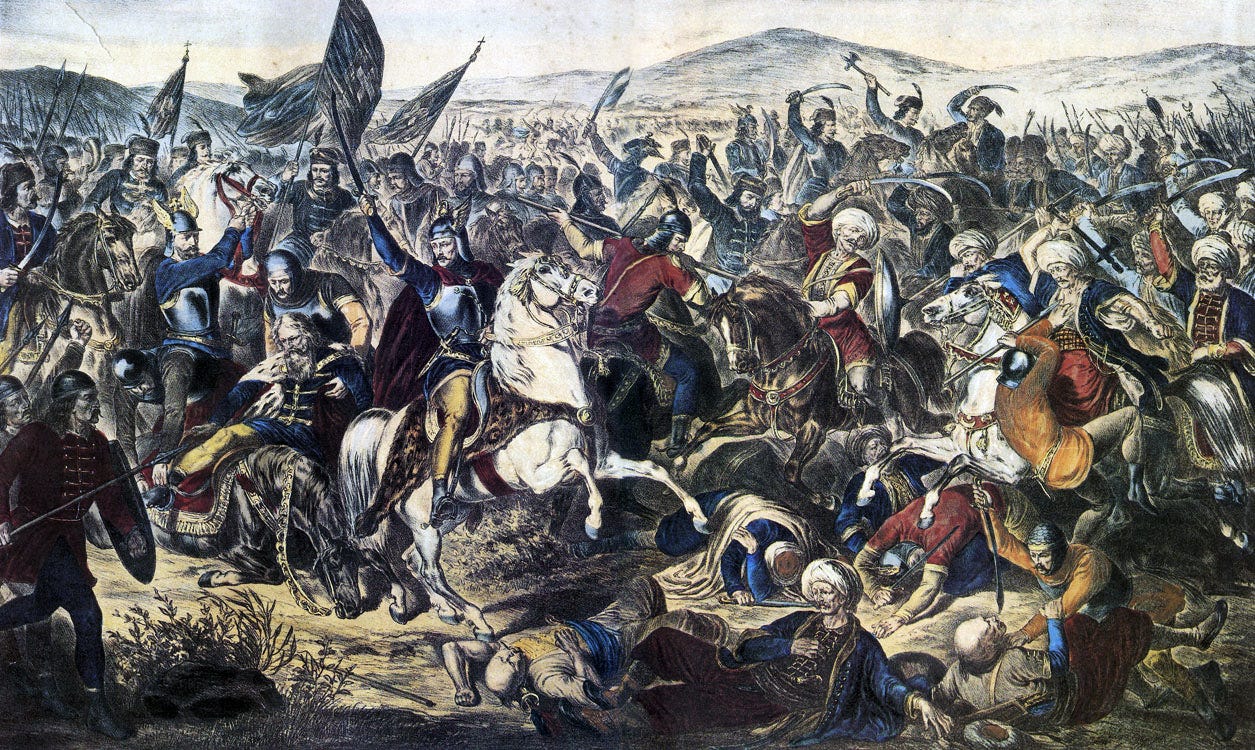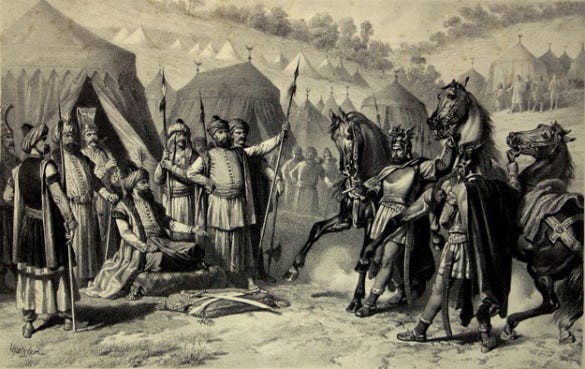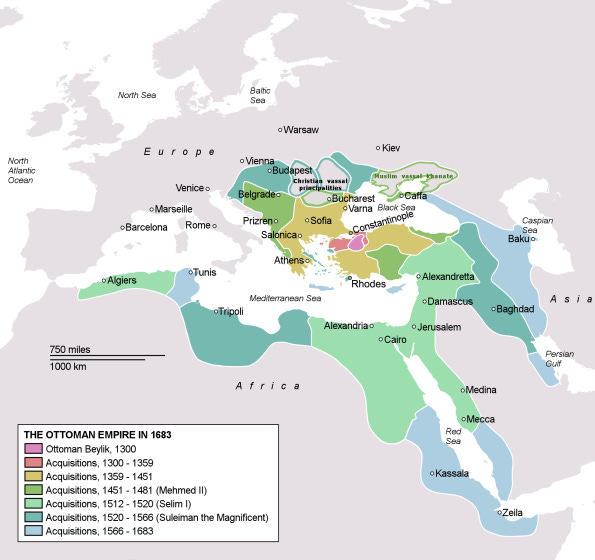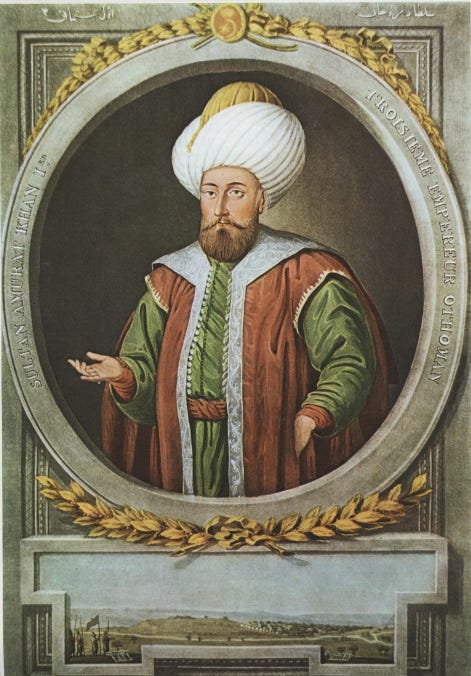Today in European history: the Battle of Kosovo (1389)
The Ottoman Empire wins a major, if narrow, victory in Europe in a battle that later became a focal point for Serbian nationalism.
If you’re interested in history and foreign affairs, Foreign Exchanges is the newsletter for you! Sign up for free today for regular updates on international news and US foreign policy, delivered straight to your email inbox, or subscribe and unlock the full FX experience:
Today is the anniversary of the 1389 Battle of Kosovo. It’s necessary to specify the year because there have been so many “battles of Kosovo” over the centuries. But this one, in contrast with 1369’s Battle of Kosovo or 1448’s Battle of Kosovo or 1831’s Battle of…well, you get the idea, is the one most people probably think of when you say “the Battle of Kosovo.” This Battle of Kosovo, though tactically inconclusive, was a strategic Ottoman victory that both set the stage for early Ottoman domination of the Balkans and became the touchstone for Serbian national consciousness. It’s an important battle with far-reaching implications that is unfortunately not very well-documented (a common problem in early Ottoman history). But we’ll do the best we can.
The Ottomans conducted their first military campaigns into Europe under their second ruler, Orhan, though these initial expeditions amounted to no more than some tentative forays into Thrace. When Orhan died and was succeeded by Murad I, in 1362, the Ottomans built on those earlier expeditions. Although Murad lost Gallipoli to Amadeo of Savoy in 1366, his westward advance was unaffected. The Byzantine city of Adrianople (modern Edirne) fell to the Ottomans either in 1362 (give or take) or 1369 (more recent scholarship suggests the latter date). Murad, who saw the possibilities that lay to the west, quickly moved his capital to Adrianople from the Anatolian city of Bursa, and it remained there until the Ottomans captured Constantinople in 1453.
Gallipoli, if you’re curious, was given back to the Ottomans in the late 1370s by Byzantine emperor Andronikos IV (d. 1385), a payment for the Ottoman military aid that allowed him to win the throne. But I digress.
Actually we should continue to digress for a bit longer, because I think Murad deserves a bit of description. Murad’s father, Orhan (d. 1362), was the son and heir of the eponymous founder of the Ottoman Empire, Osman (Osman I to be specific). Today we would call him the second sultan of that empire but I think that’s ahistorical for two reasons: one, there’s good evidentiary reason to believe that Ottoman rulers didn’t use the title “sultan” until Murad I; and two, calling the Ottoman principality an “empire” at this point is stretching things quite a bit. Orhan’s favorite son and likely heir, Süleyman Pasha, died in a hunting accident in 1357 and thus threw the succession plan into disarray. Instead of an orderly transition that likely would have seen Süleyman ruling but with high positions for his brothers, what ensued was effectively a civil war.
Murad of course won the succession conflict, putting to death his brothers Ibrahim Bey and Halil Bey to secure the throne. I mentioned that Murad was probably the first Ottoman ruler to use the title “sultan,” which was retroactively applied to Osman and Orhan, and the reason I think it’s worth giving him a couple of paragraphs here is because his reign actually sees a number of Ottoman “firsts.” As noted above he gives the empire its first “European” capital in Adrianople/Edirne. His succession and execution of his brothers also establishes a couple of core Ottoman principles: unigeniture, or the idea that the empire would pass from each sultan to one heir only and would not be divided among multiple sons; and unigeniture’s unfortunate practical component, royal fratricide. The former would help define the empire throughout its existence and the latter would only go away in the late 16th century at the accession of Sultan Ahmed I (d. 1617).
Murad is also responsible for at least one other development we should note. It was during his reign that the Ottomans instituted a tax on all slaves taken in war, and from that levy Murad created the Janissary Corps. Initially conceived as a relatively small body of warriors directly loyal to the sultan, the corps grew (particularly after conscription shifted from wartime slaves to the devshirme, a levy on the children of the Ottomans’ Christian subjects) into a full-fledged army, the first modern standing army organized around the adoption of firearms. While the Janissaries don’t factor heavily into this story, they’re obviously a huge part of the empire’s history and the devshirme became not just the source of its military might but also provided the pool of candidates to serve in its massive bureaucracy. OK, now back to the story.
Major cities fell to the Ottomans one after the other: Sofia, in Bulgaria, in 1385; Niš, in Serbia, in 1386; and Thessaloniki, in Macedonia (Greek Macedonia today), in 1387. Murad’s Ottoman forces also fought a series of engagements against the Serbs. The Ottomans won a major victory over the short-lived “Serbian Empire” at Maritsa, in 1371, which helped precipitate its breakup, but engagements at Dubravnica (1380 or 1381) and Pločnik (between 1385 and 1387) were won by Moravian Serbia, the most powerful of the empire’s successor kingdoms. In the latter battle, the Serbs were led by their prince, Lazar Hrebeljanović, who would also lead them, and die in the process, at Kosovo. Another battle, in 1388 at Bileća, ended in an Ottoman defeat at the hands of the Bosnians.
The successive defeats at Pločnik and Bileća should have stymied the Ottomans’ advance for a short time, but a dispute involving an Ottoman vassal quickly brought them back into the western Balkans. The vassal in question was the ruler of Zeta (more or less modern Montenegro), Đurađ II (d. 1403). He got into a spat with Tvrtko I (d. 1391), the King of Bosnia (who also claimed to be king of Serbia). Murad probably saw an opening to subjugate Bosnia, so he once again led his army west. However, to get to Bosnia, or to get to the Serbian principality ruled by Vuk Branković (d. 1397), another potential Ottoman target, Murad’s army had to go through Lazar’s territory. Lazar decided to meet him, joined by Branković—and I don’t mean in a friendly, “welcome to the neighborhood” kind of way.
As I said, not much is directly attested in terms of how the battle proceeded. Lazar presumably chose the site, so he had the advantage in that sense. The Ottoman army probably outnumbered the Serbs, but not overwhelmingly (upper estimates suggest maybe 40,000 men vs. around 30,000). It’s important to understand that this was not the Ottoman army you might be familiar with from later Ottoman history. It was not a gunpowder-heavy army, it was not infantry-dominated, and the Janissaries were at this point a very small force, not much more than an imperial bodyguard. This was a cavalry-centric force where the infantry was expected to absorb the enemy attack at the center while the cavalry rode around the field and did most of the damage. Lazar’s army would have been similarly cavalry-oriented.

Unfortunately, one of the details that’s too sketchy to say much about is precisely how Lazar was killed. We know that the fighting was very fierce and that both armies inflicted substantial damage on each other, and the tide didn’t really shift decisively in the Ottomans’ favor until Lazar fell and, subsequently, Branković fled the field. At that point the Serbian army began to break. We are a little better informed about the death of Murad, though this story has probably gotten somewhat lost in the Serbian legend that grew up around it. According to the legend, one Serbian knight named Miloš Obilić rode to the Ottoman lines declaring his intention to defect. He was then given an audience with Murad, at which point he pulled out a dagger and killed the Ottoman ruler before being killed himself. The Ottoman version is a bit less dramatic—it has Murad being killed by a group of Serbs while surveying the field after the battle was more or less over. Whichever version is correct the figure of Miloš (alongside Lazar) became a Serbian national hero, and his legend was used to particularly ugly effect during the Serbian ethnic cleansing campaigns in Bosnia and Kosovo in the 1990s.

The final result of the battle was mutual destruction. Both armies were gutted and both leaders lay dead on the field. What determined the outcome was the fact that the Ottomans had the capacity to absorb the loss of nearly an entire army and simply replace it, a capacity that Serbia couldn’t match. Bosnia, somewhat surprisingly, remained out of Ottoman hands until the 1460s, though Tvrtko I’s already dubious claim to the kingship of Serbia was rendered totally fictitious when Stefan Lazarević (d. 1427), Lazar’s son and successor, put Serbia under Ottoman protection. Given the shape his army was in, Lazarević really had no choice but to become an Ottoman vassal. And with that, there ceased to be any principality in the Balkans strong enough that it could realistically hope to ward off Ottoman domination.
Murad was succeeded by his son, Bayezid I (d. 1403), known as Yıldırım or “Thunderbolt,” who learned of his father’s death and then arranged for his younger brother, Yakub, to be summoned to the sultan’s tent. Upon his arrival Bayezid had Yakub strangled to death to forestall any sort of succession conflict. Bayezid had a very successful reign from a conquest perspective (albeit largely in Anatolia rather than Europe), until he ran into Timur at Ankara in 1402 and was defeated so thoroughly that the whole Ottoman Empire was shattered and remained so for the next decade. That defeat was so thorough that Lazarević immediately seized the opportunity to assert Serbia’s independence again. His Despotate of Serbia would survive until the rebuilt Ottomans ended it in 1459.
In historical terms, Kosovo was important at the time because it confirmed that the Balkans were within the Ottoman Empire’s reach. But its most enduring legacy belongs to the Serbs. Though it was a Serbian defeat, Kosovo was later cast as a heroic resistance to Ottoman encroachment and became, for better and for worse, one of the foundations upon which Serbian national identity was built.



